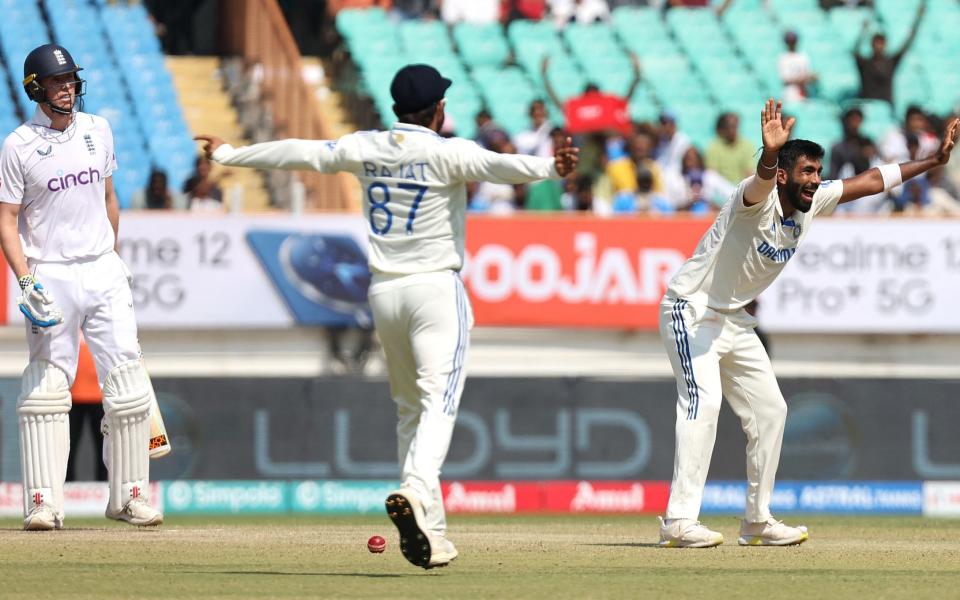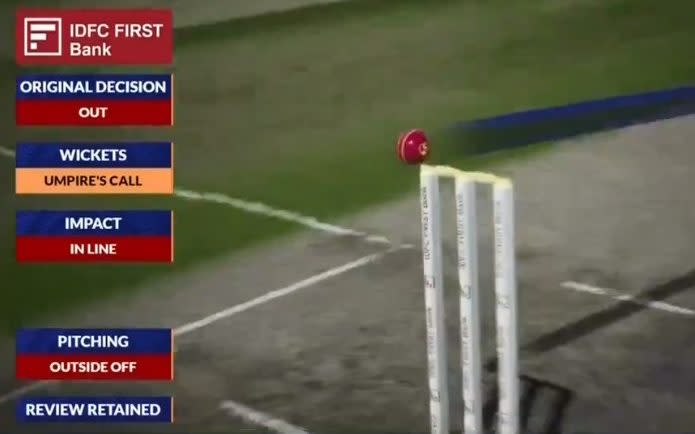What our experts would change about cricket’s review system

England coach Brendon McCullum has backed his captain Ben Stokes’s plea for “umpire’s call” to be scrapped from the Decision Review System’s adjudication on LBW.
Match referee Jeff Crowe sought out Stokes and McCullum after they were drubbed in the third Test at Rajkot, because of confusion over Zak Crawley’s leg-before dismissal by Jasprit Bumrah. Crowe explained that incorrect pictures had appeared on the TV broadcast, appearing to show the ball missing the stumps. He clarified that Hawkeye data projected that it would hit the stumps.
“I don’t really understand the system to be honest,” said McCullum on Monday. “But if Stokesy says that, he’d have put a lot of thought into it and if he’s saying that then yeah I’d agree with him. There’s obviously a couple decisions in the last few Tests that have been 50/50 calls that have had quite big impacts on the Test matches.
“There’s just an element of a bit of frustration, the one on Zak Crawley was the most frustrating because he’s in such good touch and the information that we got back from the match ref and the DRS people was that whilst there was a clear gap between the ball and the wicket [in the pictures], that was actually incorrect and the data said that it was going to hit, that’s a little hard from a layman’s point of view to understand how that works.”
Zak Crawley is OUT 🚫
Jasprit Bumrah has now dismissed every member of this England team bar Mark Wood in the series.#INDvENG pic.twitter.com/ZrFX9qth9w— Cricket on TNT Sports (@cricketontnt) February 18, 2024
Telegraph Sport’s cricket writers debate whether Umpire’s Call should be retained, or removed.
Get on with it and stop whinging
Batsmen have moaned about LBWs – especially in defeat – since the law was introduced in the 18th century and that will continue regardless of what changes are made to DRS. Umpire’s call exists for the margin of error in the predictive element of Hawkeye. Yes, the margin of error from an umpire is greater than the incredibly accurate ball-tracking technology but by and large the officials get most of the decisions correct.
Taking away umpire’s call and following Stokes’s suggestion will make the stumps bigger and you will still get those marginal decisions when the ball is clipping. In that scenario the blame will shift from the umpires to doubts about the technology. In other words, get on with it and stop whinging.
Tweak how umpire’s call is implemented
The Decision Review System has exposed that, for most of cricket history, far more batsmen should have been given out LBW than actually were. Many umpires effectively adjudged leg-befores as if there were two stumps – from the middle of off stump to the middle of leg stump – not three. This helps to explain the unhappiness among batsmen with DRS today.
Still, complications are inevitable. Consider two deliveries: Jason Roy’s first ball of the 2019 World Cup final, from Trent Boult; and Zak Crawley’s dismissal against Jasprit Bumrah in Rajkot. The first looks like it is crashing into the middle of leg stump; the second that it is clipping the top of leg stump. Based both on the height and the width, Boult’s ball looks more ‘out’ than Bumrah’s. Yet only the second was given out; in each case, the umpire’s decision on the pitch stood. It is an imperfect situation yet, once you accept that a) DRS has improved decision-making and b) DRS is not infallible, particularly on matters of height this feels unavoidable. Scrapping umpire’ call altogether, of course, would make batsmen furious. In cases like Crawley’s, the batsmen would be out on review regardless of the on-field decision.

But perhaps one modification would be reasonable. In rare cases when an LBW decision is umpire’s call on two of the three matters – where the ball pitched, ball impact and whether it is hitting the wickets – batsmen could be given not out, which would enshrine the principle of batsmen getting the benefit of the doubt and be a way of the system acknowledging that tracking is not infallible. Still, even that raises questions: why are batsmen any more deserving than bowlers?
Keep technology in cricket the same
I must admit, it’s a while since I have thought much about all this, because I generally feel technology in cricket works pretty well. Umpiring is seriously hard, especially in India, where there’s so much spin involved and often so much noise in the ground and around the bat.
Umpire’s call provides a margin for error in the predictive nature of the technology, which can never know absolutely for certain how the ball would have travelled after it hit the pad. As Nasser Hussain explains in this outstanding video, the stumps would get a hell of a lot bigger if we followed Stokes’s suggestion.
DRS keeps balance between bat and ball correct
Former Australia captain Ian Chappell, now the sport’s elder statesman, once told me that the chief function of administrators is to keep the right balance between bat and ball. At present, in Test cricket, the balance between bat and ball is about right, with totals around 300 – not 600 or 60 – and games ending in a definite result.
Getting rid of umpire’s call, and giving the batsman out LBW for any ball that is not only hitting but even brushing the stumps, will handicap batsmen so much as to disrupt the balance and make low totals far more common. England have had the rough in this series, with their batsmen dismissed by balls hitting the outside of off and leg stump, but it will even out in time.

